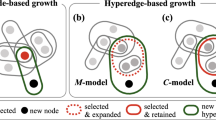Abstract
In this paper, we consider a growing network with preferential linking and power function increasing density of links and prove that the degree distribution of the network is power law with exponents less than 2.
Similar content being viewed by others
References
Aiello, W., Chung, F., Lu, L.: A random graph model for power law graphs. Exp. Math. 10, 53–66 (2001)
Aiello, W., Chung, F., Lu, L.: Random evolution in massive graphs. In: Abello, J., et al. (eds.) Handbook on Massive Data Sets, pp. 97–122. Kluwer Academic, Dordrecht (2002)
Albert, R., Barabási, A.: Statistical mechanics of complex networks. Rev. Mod. Phys. 74, 47 (2002)
Barabási, A., Albert, R.: Emergence of scaling in random networks. Science 286, 509–512 (1999)
Barabási, A., Albert, R., Jeong, H.: Mean-field theory for scale-free random networks. Physica A 272, 173–187 (1999)
Bollobás, B., Riordan, O., Spencer, J., Tusnády, G.: The degree sequence of a scale-free random graph process. Random Struct. Algorithms 18, 270–290 (2001)
Bonato, A.: A survey of models of the web graph. In: Proceedings of Combinatorial and Algorithmic Aspects of Networking, pp. 159–172 (2004)
Chung, F., Dewey, G., Galas, D.J., Lu, L.: Duplication models for biological networks. J. Comput. Biol. 10, 677–688 (2003)
Cooper, C., Frieze, M.: A general model of web graphs. Random Struct. Algorithms 22, 311–335 (2003)
Cooper, C., Frieze, A., Vera, J.: Random deletion in a scale free random graph process. Internet Math. 1, 463–483 (2004)
Dorogovtsev, S.N., Mendes, J.F.F.: Effect of the accelerated growth of communications networks on their structure. Phys. Rev. E 63, 025101 (2001)
Dorogovtsev, S., Mendes, J.: Accelerated growth of networks. In: Bornholdt, S., Schuster, H.G. (eds.) Handbook of Graphs and Networks: From the Genome to the Internet. Wiley-VCH, Berlin (2002)
Erdös, P., Rényi, A.: On random graphs I. Publ. Math. (Debr.) 5, 290–297 (1959)
Fiorini, P.M., Sheahan, R., Lipsky, L.: On unreliable computing systems when heavy-tails appear as a result of the recovery procedure. ACM SIGMETRICS Perform. Eval. Rev. 33(2), 15–17 (2005)
Gilbert, E.N.: Random graphs. Ann. Math. Stat. 30, 1141–1144 (1959)
Jelenković, P.R., Tan, J.: Can retransmissions of superexponential documents cause subexponential delays? In: Proceedings of IEEE INFOCOM’07, Anchorage, May 2007
Jelenković, P.R., Tan, J.: Is ALOHA causing power law delays? Tech. Rep., Dept. of Electrical Engineering, Columbia University (2006)
Kumar, R., Raghavan, P., Rajagopalan, S., Sivakumar, D., Tomkins, A., Upfal, E.: Stochastic models for the web graph. In: Proceedings of the 41st Annual Symposium on Foundations of Computer Science (FOCS2003) (2003)
Osthus, D., Buckley, G.: Popularity based random graph models leading to a scale-free degree distribution. Discrete Math. 282(1–3), 53–68 (2004)
Park, K., Willinger, W. (eds.): Self-Similar Network Traffic and Performance Evaluation. Wiley-Interscience, New York (2000)
Sheahan, R., Lipsky, L., Fiorini, P., Asmussen, S.: On the completion time distribution for tasks that must restart from the beginning if a failure occurs. In: MAMA 2006 Workshop, Saint-Malo, France, June 2006
Acknowledgements
The authors are very grateful to the anonymous reviewers for their careful reading, helpful comments and suggestions, which have helped the authors to improve the presentation of this work significantly. The first author has been supported by a Visiting Fellowship funded by the Leverhulme Trust and this research was supported by the Research Foundation of Education Bureau of Zhejiang Province, NSFC (60872060/11101284) and Shanghai City-level Finance Departmental Budget Project (1139IA0013).
Author information
Authors and Affiliations
Corresponding author
Rights and permissions
About this article
Cite this article
Yan, YZ., Tu, WQ. & Tang, Lj. A web model with power law exponents less than 2. J. Appl. Math. Comput. 43, 91–98 (2013). https://doi.org/10.1007/s12190-013-0653-5
Received:
Published:
Issue Date:
DOI: https://doi.org/10.1007/s12190-013-0653-5




